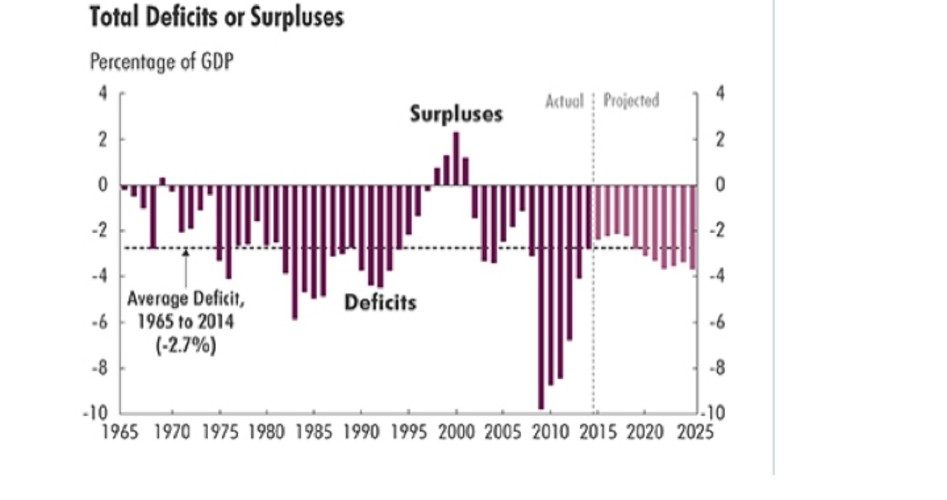
The nonpartisan Congressional Budget Office (CBO) has released a grim report regarding projected federal spending and revenues, concluding that the present course of deficit spending cannot continue indefinitely.
CBO Director Keith Hall told reporters, “This is an unsustainable path here for federal debt. At some point, it’s going to get to a very high level. Obviously, you can’t predict tipping points, but at some point this becomes a problem.”
It is a stark commentary on the magnitude of just how much federal deficits have exploded in recent years, that this year’s deficit is forecast to “fall” to $426 billion, which would be the lowest level during the presidency of Barack Obama. The record annual deficit was $1.4 trillion in 2009, the first year of Obama’s tenure, when the government dramatically increased spending, following flawed Keynesian economic theory in a futile attempt to pull the country out of the worst economic downturn since the Great Depression.
Annual deficits are expected to fall even further next year — to $414 billion — but then to begin growing again, topping $1 trillion by 2025.
Hall asserted that a deficit of that size — 77 percent of the nation’s economy — would result in soaring interest rates.
The CBO report noted that the long-term outlook for the federal budget had worsened “dramatically” in the aftermath of the 2007-09 recession, and the following weak recovery. “Between 2008 and 2012, financial turmoil and a severe drop in economic activity, combined with various policies implemented in response to those conditions, sharply reduced federal revenues and increased spending,” the report added. In only five years, deficits totaled $5.6 trillion, and in four of the five years, the deficits were “larger relative to the size of the economy than they had been in any year since 1946.” (Fiscal year 1946 included part of 1945 and the enormous spending involved in fighting WWII.)
One of the negative effects that can be expected from such large deficits is that the government’s creditors will insist on much higher interest rates in order to borrow money. Such a move, of course, would worsen the problem, as ever increasing amounts of dollars would be spent just to pay the interest on the national debt — and thus would not be spent on the principal. The CBO predicts that economic output would be lower, leading to even less revenue, which in turn would cause an even larger increase in the national debt.
An aging population (not surprising, since over 50 million unborn babies have been aborted since the Roe v. Wade decision in 1973), coupled with a ballooning number of Americans receiving subsidies though the healthcare exchanges and increased Medicaid benefits under ObamaCare, will cause federal spending to skyrocket. The CBO predicts that within 10 years, about $7.4 trillion more will be added to the national debt.
Federal spending is projected to rise from the present 20.5 percent of the gross domestic product (GDP) to 25.3 percent by 2040, mainly because of increased federal outlays for Social Security, Medicare, Medicaid, the Children’s Health Insurance Program, and subsidies for health insurance purchased through ObamaCare’s exchanges.
Federal revenues are also expected to rise under current law relative to GDP, but just not as much as federal spending. By 2040, revenues going to the federal government would equal 19.4 percent of GDP (the 50-year average is 17.4 percent). The principal cause of the anticipated increases in federal revenues would be because American taxpayers would be pushed into higher tax brackets over time.
The CBO predicts that the debt will reach 103 percent of GDP by 2040.
This will produce what is often called the “crowding-out effect.” Federal borrowing would draw money away from private investment in productive capital, because a larger portion of private savings available to lenders would be used to buy government securities, rather than to finance private investment. The results would be stagnant growth, less business activity, and fewer jobs in the private sector. And, of course, less federal revenue, and an ever-growing federal debt.
As federal spending on interest payments increases, the government will either have to raise taxes or reduce spending for benefits and services. Most likely, both will become part of the mix. Defense spending would be a likely target of budget cutters, rather than popular social programs.
Attempting to solve this problem simply by raising taxes appears impossible. As the CBO report noted, “Such a policy would require boosting revenues by 14 percent in each year over the 2016-2040 period relative to the amounts that CBO projects in the extended baseline. For households in the middle fifth of the income distribution in 2016, a 14 percent increase in all types of revenues would raise federal tax payments for that year by about $1,700, on average.”
The longer Congress fails to address this problem, the more difficult it will be to solve.
Not surprisingly, Democrats and Republicans had different reactions to the gloomy CBO report. House Budget Committee Chairman Tom Price, a Republican from Georgia, emphasized the need to reduce federal spending. “Without control over spending, our nation will lose control over its own future,” he declared.
But Democrats such as Chris Van Hollen of Maryland, the ranking member of his party on the budget committee, disagreed. He indicated that more spending is the way to attack the deficit, arguing that spending on education and other government programs such as on infrastructure are “investments.” Many Democrats added that it was time to close tax breaks. White House spokesman Eric Schultz warned Congress against budget cuts. “We need to stay focused on this route and avoid self-inflicted wounds,” he insisted in reference in to a possible government shutdown.
While Democrats viewed the short-term drop in annual deficits as a sign of progress, former Senator Judd Gregg, now a co-chairman of the group Fix the Debt, countered, “I don’t know how anyone can declare victory when trillion-dollar deficits are just on the horizon.”
Unfortunately, when the Republicans were last in control of both the White House and the Congress, they also dramatically increased federal spending, even adding new federal programs, as well as conducting a horifically expensive war in Iraq.
Interestingly, despite the seriousness of the problem, the growing national debt has hardly been mentioned by the 2016 presidential hopefuls of either party.
While trimming spending for federal programs would certainly be helpful in shrinking the debt, what would really make a difference is the elimination of several unconstitutional departments — such as Education and Energy. After all, the country did just fine before these two departments were added to the already bloated federal government in the 1970s. It is also politically important to raise popular support for other less popular cuts in federal spending. For example, drastically reducing foreign aid, with the goal of ending it altogether, though not solving the problem of the national debt, would at least demonstrate to the cynical public that Congress is serious about addressing it.
Budget Director Hall dismissed the idea of using tax cuts to reduce deficits. “The evidence is that tax cuts do not pay for themselves,” he claimed. Actually, the historical evidence is clear that tax reductions tend to increase federal revenues. The Harding-Coolidge tax cuts of the 1920s created a significant increase in federal revenue, and greatly reduced the national debt. The Kennedy tax cuts of the 1960s also increased federal revenue, as did the Reagan tax cuts of the 1980s.
The problem in the 1960s and the 1980s was not that federal revenues declined — they increased, actually — but rather that both times, the government increased federal spending even more than federal revenues. In the 1980s, revenues generated by the income tax doubled, but federal spending tripled. By contrast, in the 1920s, Presidents Warren Harding and Calvin Coolidge combined tax cuts with cuts in federal spending, and the national debt actually declined.
Hopefully, a significant number of congressmen will return from their recess with the will and the courage to get serious about the national debt — already approaching $19 trillion.
Steve Byas is a professor of history and government at Hillsdale Free Will Baptist College in Moore, Oklahoma. His new book, History’s Greatest Libels, defends many personalities in history whom he believes have been unfairly maligned.


